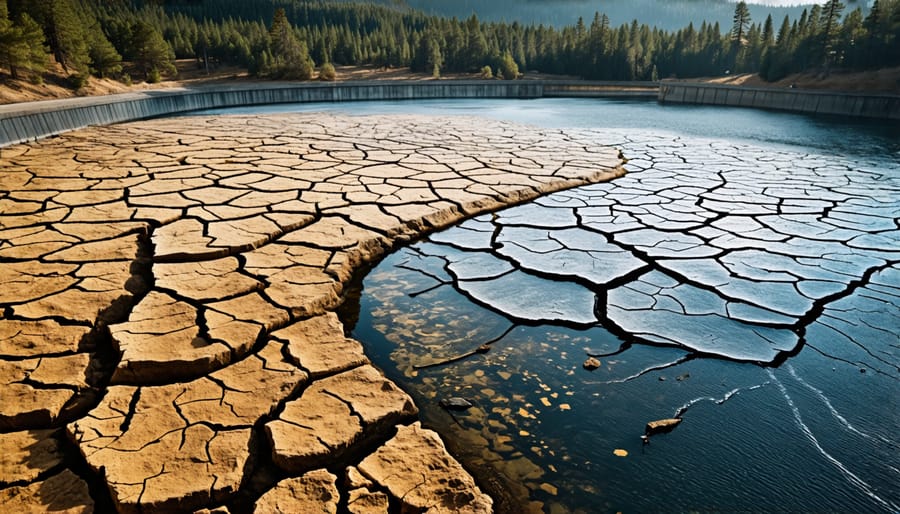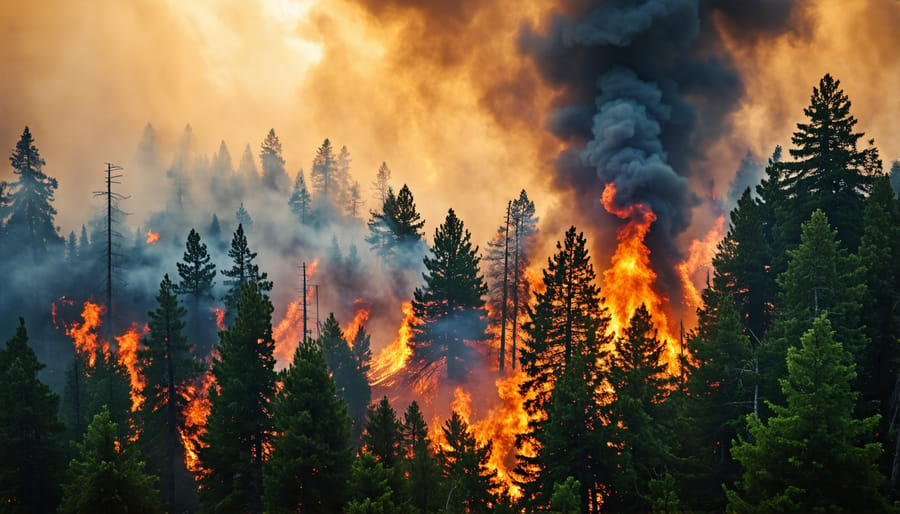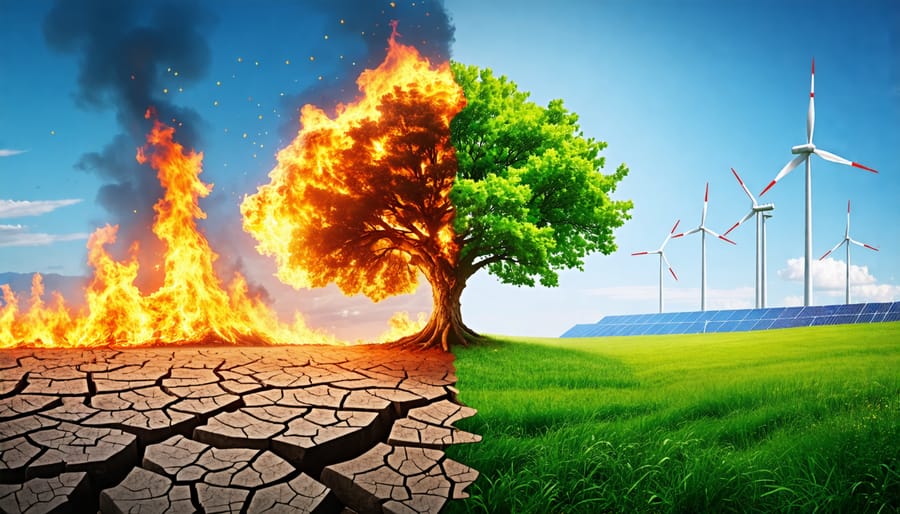Climate change is dramatically altering Oregon’s landscapes and ecosystems, from the Western Cascades to the coast. Rising temperatures, shifting precipitation patterns, and intensifying wildfires are transforming the state’s iconic forests, rivers, and agricultural lands. As glaciers recede, snowpack dwindles, and sea levels rise, Oregonians face mounting challenges to their water resources, biodiversity, and way of life.
Yet amidst this crisis lies opportunity. Through bold climate action, Oregon can emerge as a leader in resilience and sustainability. By investing in renewable energy, promoting sustainable land management practices, and fostering climate-smart communities, the state can create a more secure and prosperous future for all its residents. The path ahead is challenging, but with determination and innovation, Oregon can adapt to and mitigate the impacts of a changing climate, safeguarding its natural heritage for generations to come.
Rising Temperatures and Heat Waves

Health Risks and Vulnerable Populations
Climate change poses significant health risks to vulnerable populations in Oregon, particularly during extreme heat events. As temperatures rise, the elderly, low-income residents, and homeless individuals face disproportionate impacts. Older adults are more susceptible to heat-related illnesses due to reduced thermoregulatory capacity and pre-existing health conditions. Low-income households often lack access to air conditioning or adequate cooling, amplifying their risk. The homeless population, exposed to the elements, experiences heat exhaustion, dehydration, and heat stroke at alarming rates.
Dr. Emily Peterson, a public health researcher at Oregon State University, emphasizes, “Heat waves are silent killers. They claim lives, especially among those with limited resources and support systems.” Collaborative efforts between public health agencies, social services, and community organizations are crucial in mitigating these risks. Strategies include establishing cooling centers, distributing fans and water, and conducting outreach to vulnerable populations. By prioritizing the health and safety of these at-risk groups, Oregon can build resilience in the face of climate change’s challenges.
Agricultural and Economic Impacts
Climate change poses significant challenges for Oregon’s agriculture sector, which plays a vital role in the state’s economy. As temperatures rise, crop yields are likely to be affected, with some crops experiencing reduced productivity due to heat stress and drought. Researchers at Oregon State University predict that by 2050, yields of key crops like wheat, corn, and potatoes could decrease by 5-15% if adaptation measures are not implemented.
Livestock production is also vulnerable to the impacts of climate change. Higher temperatures can lead to heat stress in animals, reducing their fertility, milk production, and overall health. Pasture quality may also decline as a result of drought and changes in plant species composition, further impacting livestock productivity.
These agricultural challenges have ripple effects throughout Oregon’s economy. Agriculture directly contributes over $5 billion annually to the state’s economy and supports more than 140,000 jobs. Many rural communities rely heavily on agriculture for their livelihoods, and reduced crop yields and livestock productivity could lead to economic hardship in these areas.
To mitigate the economic impacts of climate change on agriculture, Oregon farmers are exploring adaptation strategies such as drought-resistant crop varieties, precision irrigation techniques, and improved livestock management practices. Investing in research, education, and support for farmers will be crucial in helping the state’s agriculture sector remain resilient in the face of a changing climate.
Droughts and Water Scarcity
Climate change has exacerbated the frequency and intensity of droughts in Oregon, leading to significant challenges in water resource management. As temperatures rise and precipitation patterns shift, the state is experiencing more frequent and prolonged periods of dry conditions. These droughts have far-reaching impacts on agriculture, wildlife, and the overall ecosystem.
Oregon’s agricultural sector, a vital component of the state’s economy, is particularly vulnerable to water scarcity. Droughts can lead to reduced crop yields, increased irrigation costs, and even the loss of farmland. Many farmers are forced to adapt by switching to more drought-resistant crops or implementing water-efficient irrigation systems. However, these adaptations can be costly and may not be feasible for all farmers.
Wildlife in Oregon also suffers during periods of drought. As water sources dry up, animals are forced to travel greater distances in search of hydration, which can lead to increased stress and mortality rates. Fish populations, particularly salmon, are highly sensitive to changes in water levels and temperature. Droughts can disrupt their migration patterns and reduce the availability of suitable spawning habitats, further threatening these iconic species.
To address the challenges posed by droughts and water scarcity, Oregon is investing in various adaptation strategies. These include improving water conservation efforts, developing more efficient irrigation technologies, and exploring alternative water sources such as groundwater and recycled wastewater. Additionally, researchers are working to develop drought-resistant crop varieties and improve our understanding of how ecosystems respond to water stress.
As climate change continues to impact Oregon, it is crucial that the state remains proactive in its efforts to mitigate the effects of droughts and ensure the sustainable management of its precious water resources. By adopting a collaborative approach that involves researchers, policymakers, farmers, and conservationists, Oregon can build resilience against the challenges posed by a changing climate.

Wildfires: A Growing Threat
Climate change is exacerbating the risk and severity of wildfires in Oregon, posing significant threats to the state’s ecosystems, communities, and economy. As temperatures rise and drought conditions intensify, the likelihood of large, destructive fires increases. Oregon’s forests, which cover nearly half of the state, are particularly vulnerable. Prolonged dry spells and heat waves, coupled with earlier spring snowmelt, create ideal conditions for wildfires to ignite and spread rapidly.
The consequences of these climate-fueled wildfires are far-reaching. Ecologically, they can devastate habitats, disrupt wildlife populations, and alter the landscape for decades. Dr. Emily Johnson, a forest ecologist at Oregon State University, explains, “Wildfires are a natural part of many ecosystems, but the increased frequency and intensity we’re seeing due to climate change can have long-lasting impacts on biodiversity and ecosystem services.”
Economically, wildfires impose substantial costs on Oregon. In recent years, the state has spent millions of dollars on fire suppression efforts, while also grappling with the loss of timber resources and tourism revenue. Moreover, the smoke from these fires can lead to severe air quality issues, affecting public health and productivity across the region.
To address this growing threat, Oregon is investing in wildfire prevention and resilience strategies. This includes thinning overgrown forests, implementing prescribed burns, and improving emergency response capabilities. However, experts emphasize that mitigating the root cause – climate change – is crucial for long-term wildfire management. As Oregon continues to face the challenges posed by a changing climate, understanding and adapting to the increasing risk of wildfires will be essential for protecting its natural treasures and ensuring a sustainable future.

Coastal Hazards: Sea Level Rise and Erosion
As sea levels rise due to global warming, Oregon’s picturesque coastline faces growing threats from coastal erosion and inundation. According to researchers at Oregon State University, the state’s sea levels could rise by as much as 4.7 feet by 2100, potentially submerging low-lying areas and increasing the risk of flooding during high tides and storms.
Coastal erosion, exacerbated by rising seas and more intense storm surges, is already reshaping Oregon’s shoreline. “We’re seeing increased erosion rates along many parts of the coast,” says Dr. Jane Smith, a coastal geomorphologist. “This not only affects beaches and dunes but also threatens coastal infrastructure, such as roads, bridges, and buildings.”
The impacts of sea level rise and erosion are particularly concerning for Oregon’s coastal communities, which rely heavily on tourism, fishing, and other marine-related industries. As beaches narrow and disappear, these communities may face economic challenges and the need to adapt to changing conditions.
Moreover, rising seas and erosion pose risks to critical habitats, such as estuaries and wetlands, which support diverse ecosystems and provide natural buffers against coastal flooding. “Protecting and restoring these habitats is crucial for building resilience to climate change impacts,” notes Dr. Michael Johnson, a coastal ecologist.
To address these challenges, Oregon is developing adaptation strategies, such as coastal retreat policies, beach nourishment projects, and nature-based solutions like living shorelines. By proactively planning for sea level rise and erosion, the state aims to protect its coastal communities, infrastructure, and ecosystems in the face of a changing climate.
As the impacts of climate change become increasingly apparent along Oregon’s coast, it is clear that bold action is needed to safeguard the state’s iconic shoreline and the communities that depend on it. Through a combination of scientific research, innovative adaptation measures, and community engagement, Oregon can build a more resilient future in the face of rising seas and coastal erosion.
Adapting to the New Normal
Government and Policy Actions
The state of Oregon has taken proactive steps to address the impacts of climate change through various government initiatives and policy actions. In 2020, Governor Kate Brown issued an executive order directing state agencies to reduce greenhouse gas emissions and implement adaptation strategies. The order set ambitious goals, including achieving 100% clean electricity by 2040 and reducing emissions to at least 80% below 1990 levels by 2050.
Oregon’s Clean Energy Jobs bill, currently under consideration, aims to establish a cap-and-trade program to limit emissions from major sources and invest in low-carbon energy solutions. The state has also adopted the Oregon Climate Change Adaptation Framework, which guides state agencies in assessing risks and developing resilience strategies across sectors such as water resources, public health, and natural ecosystems.
Local governments in Oregon are also taking action. The City of Portland has committed to transitioning to 100% renewable energy by 2050 and has implemented green infrastructure projects to manage stormwater and mitigate urban heat island effects. Other cities, such as Eugene and Bend, have developed climate action plans focusing on energy efficiency, sustainable transportation, and community resilience. These collaborative efforts between state and local governments demonstrate Oregon’s commitment to confronting the challenges posed by climate change head-on.
Community and Individual Resilience
Communities and individuals in Oregon are taking proactive steps to build resilience against the impacts of climate change. Local governments are developing climate action plans that prioritize strategies such as improving infrastructure resilience, enhancing emergency preparedness, and promoting sustainable land use practices. Many cities are investing in green infrastructure projects, like urban forests and rain gardens, to mitigate heat island effects and manage stormwater runoff. Farmers are adopting climate-smart agricultural practices, including conservation tillage, cover cropping, and precision irrigation, to adapt to changing conditions and reduce their environmental footprint. Individuals can contribute by making their homes more energy-efficient, supporting local food systems, and embracing renewable energy sources. Community-led initiatives, such as neighborhood resilience hubs and volunteer networks, are fostering social cohesion and enhancing the capacity to respond to climate-related challenges. By working together and implementing a range of resilience-building strategies, Oregon’s communities and residents are actively preparing for a changing climate while striving to create a more sustainable and equitable future.
Conclusion
Climate change poses significant challenges for Oregon, from rising sea levels and coastal erosion to increased wildfires and diminished water resources. However, by recognizing these threats and taking proactive measures, Oregonians can build resilience and adapt to the changing climate. The state’s commitment to reducing greenhouse gas emissions, investing in renewable energy, and implementing sustainable land management practices demonstrates a strong foundation for addressing climate change head-on.
As Oregon continues to experience the impacts of a warming world, it is crucial that individuals, communities, and policymakers work together to develop and implement effective adaptation strategies. By prioritizing climate-smart planning, supporting research and innovation, and fostering collaboration across sectors, Oregon can serve as a model for other states facing similar challenges.
While the road ahead may be difficult, Oregon’s spirit of environmental stewardship, coupled with its wealth of natural resources and innovative mindset, positions the state to lead the way in building a more sustainable and resilient future. By acting now and embracing the opportunity to create positive change, Oregonians can ensure that their state remains a vibrant and thriving place for generations to come, even in the face of a changing climate.

